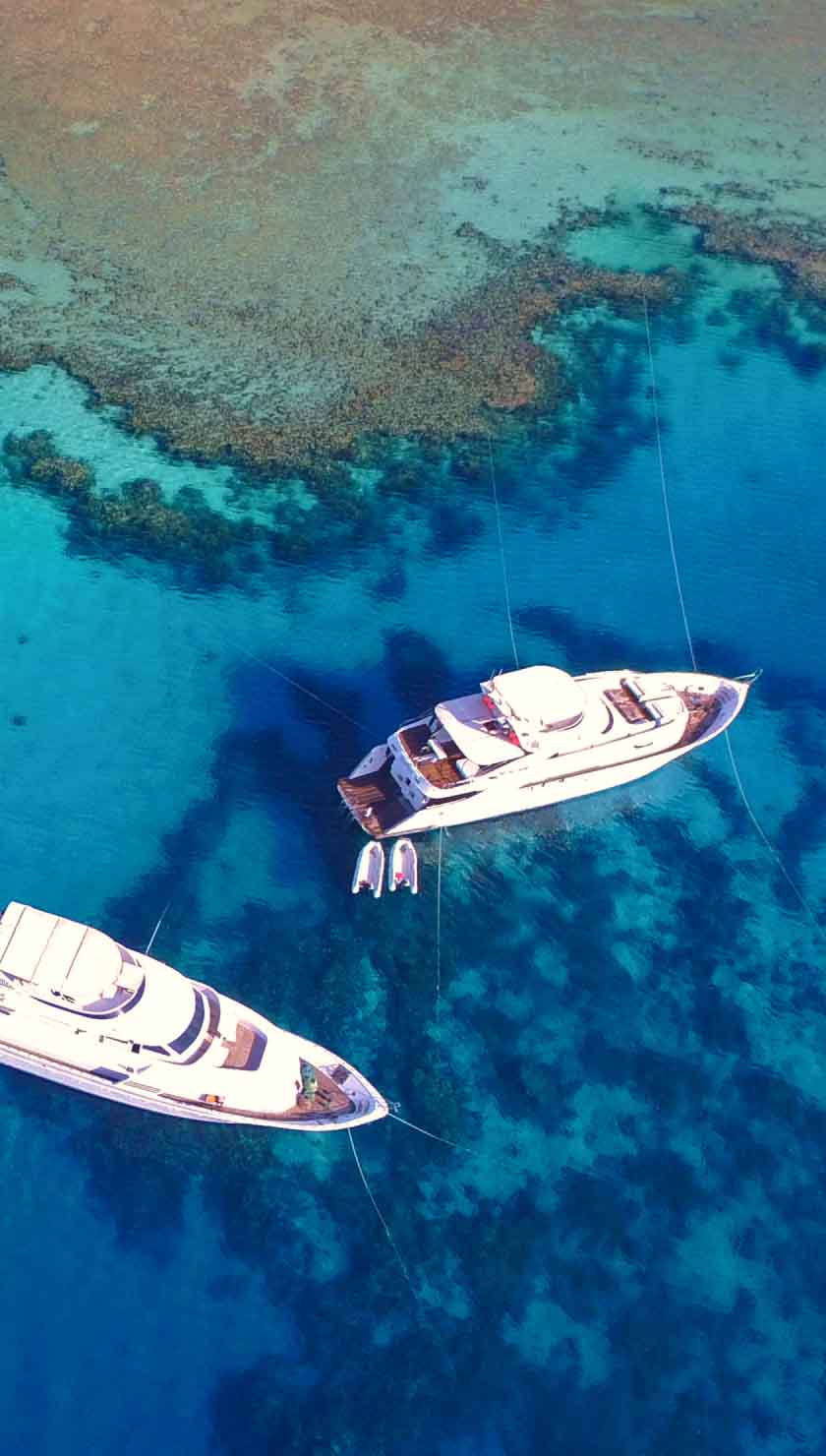Liveaboard Diving in Great Barrier Reef
What to Expect On a Great Barrier Reef Liveaboard
Take a liveaboard in the Great Barrier Reef, Australia and you will be diving one of the ultimate bucket list destinations for not just every diver, but most of the world's population. Great Barrier Reef liveaboards visit this world-famous and stunning marine area which has earned its name as a 'must visit area' in this spectacular part of the world. Delving a little deeper into people's ambitions, they'll likely cite diving on the Great Barrier Reef - popularly abbreviated to GBR - as one of their life goals. This is for good reason too, as the reef is a 2300 kilometre stretch of unrivalled natural beauty, one of the seven natural wonders of the world, a World Heritage Site, and is THE place to dive on our planet. A liveaboard dive trip is the best way to explore this region as it consists of more than 900 islands and 2900 individual reefs, forming a spectacular turquoise chain from Lizard Island in the north of Queensland, all the way down to close to Heron Island in the south of Australia's 'Sunshine' state.
A Great Barrier Reef liveaboard will take you to the crystal clear tropical waters of the Coral Sea, which is comprised of billions of coral polyps, making it the largest living organism on the planet. It is so large and vast that it is visible from outer space - even if you spent a lifetime exploring the reef, it would be impossible to view it all. Day trips are possible but will only allow you to witness the crowded inner reef for a few hours, and will leave you wishing for more time to explore what is on offer. The best way to truly experience the underwater marvels of this iconic structure is by setting sail on a diving liveaboard cruise lasting a number of days, meaning you will be able to witness a wide variety of the incredible biodiversity that the reef supports. Even aboard a liveaboard cruise, you'll still only touch the surface (pardon the pun!), and no doubt by the end you'll be thinking of planning another similar trip in the near future!
The Great Barrier Reef Underwater
Being the World's largest reef system, you can expect to see pretty much everything you could imagine on a GBR liveaboard tour. You'll see the full complement of reef fish, including Clownfish, Fusiliers, Butterfly Fish, Angelfish, Trout and Batfish, all swimming amongst a backdrop of stunningly colourful hard and soft corals.
If you look hard enough (or more likely your expert Divemaster who'll know where to look!), there's some incredible macro life to be seen as well, such as brightly patterned Nudibranchs and tiny but graceful Shrimp. You won't need to rely on your guide to spot the tons of circling Reef Sharks, elegant Turtles (green and loggerhead), and huge Manta Rays that are present at many sites frequented by liveaboard operators - you'll have to make sure you have your camera handy though as you won't want to miss these creatures in their natural habitat! Other animals that divers report sightings of frequently include Sea Snakes, Cuttlefish, and Leopard Moray Eels.
Some dive sites have their own unique attractions, none more famous than Cod Hole in the northern Ribbon Reefs, home to a friendly and docile family of giant Potato Cod (Grouper), and Maori Wrasse.
All of this life is present all year round, and if you are visiting between June and December, you may have the added bonus of viewing dwarf Minke Whales, Humpback Whales, Dolphins and the annual spectacular coral spawning.
It's also not just beautiful reefs and their associated coral gardens that are on the diving radar here either - the SS Yongala wreck is widely recognised as one the finest dive sites on the planet, situated towards the southern end of the reef.
Dive Sites & Areas On The Great Barrier Reef
It would be naive to write about every single dive site on the Great Barrier Reef, as it's likely you'd be here for a lifetime if so! The few 'best of', and on many liveaboard itineraries, are described below:
OSPREY REEF is famous for its 40m+ visibility and almost guaranteed sitings of large numbers of sharks at North Horn. Located in the Coral Sea, and accessible via liveaboard from Cairns, the reef features many small caverns and swim-throughs, making the dive sites here fun for everyone.
RIBBON REEFS Lie to the north of Cairns. Isolated they are only reachable via a few liveaboards. They are a chain of ten individual reefs offering sheltered warm waters, and due to their remoteness are in pristine condition.
MILLN REEF is a spot perfect for snorkelling and diving and is also a great place to do a night dive (sleeping turtles and crabs are common) if you wish. It consists of 3 large coral pillars, located around 60 kilometres from Cairns.
FLYNN REEF Features arguably Australia's best coral garden, is a place where you can see the full array of hard and soft coral that the GBR has on show.
COD HOLE has a resident family of giant Potato Cod which will let you take some fabulous close up photos - there are not many places you can take a selfie with a fish that is likely larger than you! Don't worry though, they're ever so friendly and curious, and love interacting with divers. Here it's common to see the sometimes even larger Maori Wrasse aswell. This site is part of the Ribbon Reefs.
LIZARD ISLAND is a national park on an island of the same name, situated to the very north of the GBR. It's a tropical paradise, ideal for unwinding after a few days of diving or honing your diving skills prior to a trip in the calm, sheltered waters that surround it.
NORTH HORN is one of the more well-known parts of Osprey Reef and is renowned for its famous shark feed, where divers are almost guaranteed to see a wide range of these predators, including Grey Reefs, Silkys, Silvertips and Hammerheads.
BOUGAINVILLE REEF benefits from an exposed position on the outer reef, which does mean it can only be visited by liveaboard and when conditions permit. As a result, it offers some of the most unspoilt and pristine diving in all of Australia, regularly frequented by Manta Rays and Turtles.
SS YONGALA WRECK is a wreck that has long been recognised as one of the finest dive sites in the world. Sunk in 1911, the ship is relatively intact, having developed a mesmerising variety of corals and boasting some of the most diverse marine life on the whole of the GBR.
Tips For Divers
There is diving to suit every level of diver on the Great Barrier Reef, from calm, gentle, warm waters for newbies, to challenging swim-throughs and caves for the more experienced. Some trips will require evidence of dive experience, but there are many that request no minimum logged dives. Most of the time full equipment is available to rent (please check this!), but remember to bring your certification. You'll also want your logbook as recording what you've seen is all part of the fun! Visibility is always great - often well in excess of 25 metres, and sometimes over 40. Water temperatures range from 22 to 30 degrees Celsius.
The native language of Australia is English, although commonly dive crews will speak a variety of others. Currency is the Australian Dollar, and ATMs are easily found onshore (not onboard though!). Internet access, healthcare, and transport in Australia are of high quality, although as always please ensure that appropriate travel insurance has been purchased.
Getting To The Great Barrier Reef
Undoubtedly the best method of exploring the GBR is sailing through the Coral Sea amongst the reef on an Australian liveaboard dive cruise.
LiveAboard.com has several cruises to choose from to suit every budget, with the vast majority departing for the Great Barrier Reef from Cairns' port in Queensland. There are a few small regional airports (for example Townsville, Rockhampton, Lizard Island) where it is possible to fly into from other areas of Australia, but by far the easiest, cheapest and convenient way to visit the reef is to fly directly into Cairns. Its airport has good international connections, allowing most visitors to fly directly from many overseas locations, although many daily flights also arrive here from the major hubs of Sydney and Melbourne, in case one of your first Australian destinations is there.











